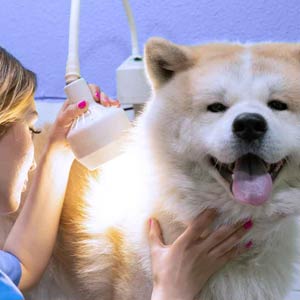While humans may experience an occasional cough, sneeze, or even bouts of asthma in response to environmental allergens, our pups are more likely to experience an uncomfortable skin condition called atopic dermatitis. Pet parents know how difficult it can be to watch their canine companion itch incessantly. So clearly this condition can cause intense discomfort.
Dermatological issues are a primary worry of many pet parents. In fact, dermatitis is one of the top three reasons owners bring their dogs to their veterinarian. Understanding the condition of atopic dermatitis can be a step in helping your pup live a happier life. We want our dogs to be healthy and comfortable. There are some things you can do to help them feel their best if itchy, irritated skin from allergies strikes.
Table of contents
- What is canine atopic dermatitis?
- Causes of canine atopic dermatitis
- What are the symptoms of CAD?
- Treatment of canine atopic dermatitis
What is canine atopic dermatitis?
Environmental allergens, such as dust, pollen, and mold (and even the human caretaker!) can cause an allergic reaction often referred to as atopic dermatitis (AD). Atopy refers to an immune system issue in which a person or animal is more likely to develop allergic diseases. Those with atopy produce an exaggerated immune response to common allergens in the environment. Immunoglobulin E (IgE), a type of antibody found in mammals, is an important part of this immune response.
Canine atopic dermatitis (CAD) is a common skin disorder. Some dogs have a hereditary predisposition to develop an itchy, inflammatory skin disease associated with elevated levels of IgE antibodies. CAD causes chronic itchiness—or pruritus—and skin lesions. These can appear as areas of skin that look different from the surrounding area (i.e. bumps or irritated patches).
Causes of canine atopic dermatitis
The most common causes of canine allergic dermatitis are flea allergy, food allergy, and inhalant or contact allergy. Dogs can also be allergic to the normal bacterial flora and yeast organisms that live on the skin of all creatures. To make matters more difficult to diagnose and treat, thyroid disease may add to the problem as well.
As previously mentioned, canine atopic dermatitis is genetic. Dogs with CAD have a hereditary predisposition to the condition. Some breeds are more prone to developing CAD than others. According to the Merck Veterinary Manual, Golden Retrievers, Bulldogs, Sheepdogs, and most terriers are often predisposed to developing atopic dermatitis.
What are the symptoms of CAD?

A dog with atopic dermatitis will usually show signs and symptoms between six months to three years of age. Experts at VCA Animal Hospitals note that the condition often begins mildly and can get worse over time. Symptoms can be either seasonal or nonseasonal. The most commonly affected areas in dogs are the feet, face, ears, armpits, and front legs. It is important to highlight that these areas are distinct from flea allergies, where the tail, groin, and thighs are usually affected.
The clinical signs of CAD can include:
- Itching, scratching, chewing, and rubbing affected skin
- Licking
- Greasy skin
- Redness or thickened skin
- Red, irritated eyes
- Inflamed ears, often with overproduction of earwax, leading to bacterial and yeast infections
- Hot spots
Dogs who suffer from atopic dermatitis may cause injury to themselves when trying to relieve itchiness and open themselves up to infection, alopecia (hair loss), and other symptoms. Lesions that develop as a result of excessive itching are at risk of developing secondary infections. With this, while CAD on its own can be uncomfortable, it is essential to consult your veterinarian if you believe your pup has CAD to rule out other conditions and help mitigate the potential risk for secondary infections.
Treatment of canine atopic dermatitis

Dermatological issues are among the most common complaints from pet owners and are a huge source of stress for both pets and their owners. So, what can you do for your pup struggling with CAD?
Dr. Darin Dell notes in DVM360 that “no single therapy is 100% effective,” emphasizing that most atopic dogs require a core treatment and at least one supportive therapy to alleviate their symptoms. The Merck Veterinary Manual notes that although canine atopic dermatitis cannot be cured, some possible management strategies include:
- Cortisone-type steroids such as glucocorticoids are often used to control atopic dermatitis. While these can be effective in reducing skin inflammation and controlling pruritus, they are not without negative side effects such as excessive urinating and increased susceptibility to infection. Additionally, used long-term, steroids can have an impact on your pup’s endocrine systems possibly leading to decreased longevity.
- Antihistamines are also used to control AD, but may not reduce symptoms in all cases. According to Dr. Dell, these products work best in a supportive role when used in conjunction with other therapies.
- Immunotherapy in the form of regular allergy injections or oral solutions may be effective and enable patients to use fewer medications, but will likely take up to a year to show signs of improvement and require long-term or even life-long use. This strategy also requires precise identification of allergens responsible for atopic reaction.
- Anti-itch shampoos may decrease pruritus, but can be harsh on irritated skin. Dogs should also be dried thoroughly after bathing to eliminate moisture that can lead to secondary infections.
- Nutritional Supplements: There are a range of nutritional supplements that may also be used as an adjuvant to dampen the atopic dermatitis response. Most popular are omega-3 fatty acids from marine sources, as well as specialized fatty acids that work with the endocannabinoid system. One of which is CBD/CBDA rich hemp oils. Pet parents should ask their veterinarian about supplements that can be effective in supporting skin health. It’s important to consult your vet if you suspect your pet is suffering from atopic dermatitis.
Any health or medical information in ElleVet blogs is from a variety of public and reputable sources. This information is intended as an educational resource only and is not a substitute for expert professional care.









